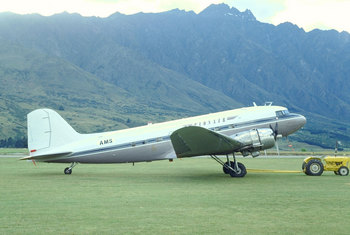Speed Lettering 11- mobiles and airlines [Column_Letters & Figures]
 : Queenstown, New Zealand Jan. 4, 1994.
: Queenstown, New Zealand Jan. 4, 1994. Comparatively many railroads adopted italic fonts to their logos in the Art Deco period.
Art Deco period was the period when mass production and mass consumption were executed. Mass production requires speed. Thus, it is easy to imagine that citizens required speed to the transportation related industries as many commercial airline carriers were established in this period.
Let’s see how transportation related industries adopted the italic fonts to their logos to find the relationship between the citizen’s demand and the italic fonts.
On the road; General Motors (including GMC, Chevrolet, Buick, Oldsmobile, Pontiac, Cadillac), Chrysler (including Chrysler, Plymouth, Dodge) and Ford Motors (including Ford. Lincoln) don’t adopt the italic fonts to their logos (Ford logo is a script).
Trailways adopted it in 1965. Greyhound adopted it in 2007.
How about major historical commercial airline carriers?
Pan American Airways (established in 1927) adopted the logo using italic font in 1930.
Delta Airlines (established in 1928) adopted the logo using italic font in 1945.
United Airlines (established in 1926) adopted the logo using italic font in 1952.
Trans World Airlines (established in 1925) adopted the Raymond Lowey designed logo using italic font in 1959.
Thus, the railroad industry adopted the italic fonts to their logos, going ahead of other transportation related industries.
Reference:
Web site representing the Trailways logo;
http://www.trademarkia.com/national-trailways-bus-system-72227861.html
Web site representing the history of Greyhound logo design;
http://en.wikipedia.org/wiki/Greyhound_Lines
Web site representing the history of Pan Am logo design;
http://www.panamair.org/History/logos.htm
Web site representing the history of Delta logo design;
http://worldsbestlogos.blogspot.com/2007/11/delta-air-lines-logo.html
Web site representing the history of UA logo design;
http://www.sitepoint.com/save-the-united-airlines-iconic-tulip/
Web site representing the history of TWA logo design;
http://www.flickr.com/groups/twa/
アール・デコの時代またはそれ以前に、比較的多くの鉄道会社がロゴに斜体を用いるようになった。
アール・デコの時代とは、今につながる大量生産・大量消費社会が成立した時代である。大量生産には効率、すなわち速度が要求される。したがって、この時代に交通機関に対する速度への要求も高まったことは想像に難くない。多くの民間航空会社がこの頃設立されていることは、このことの例証となるだろう。
速度への要求に応えうる、鉄道以外の交通機関には、道路(自動車)や空路(飛行機)が考えられる。そこで、自動車メーカーや航空会社のロゴを概観し、社会の要求と斜体によるスピード感の関連について考察する。
北米三大自動車メーカーGeneral Motors(GMC、Chevrolet、Buick、Oldsmobile、Pontiac、Cadillacなど)、Chrysler(Chrysler、Plymouth、Dodgeなど)、Ford Motors(Ford、Lincolnなど)のロゴはいずれも斜体を用いていない。ちなみにバス会社Gleyhound Linesの斜体を用いたロゴは、犬こそ1927年からであるが、斜体自身は2007年の導入である。
北米の歴史ある主要民間航空会社トランスワールド航空(1925年設立)、ユナイテッド航空(1926)、イースタン航空(1926)、ノースウエスト航空(1926)、パンアメリカン航空(1927)、デルタ航空(1929)、アメリカン航空(1930)、コンチネンタル航空(1934)ではどうだろう。
Pan Amが斜体を用いたロゴを導入したのは1930年である。Deltaは1945年に導入している。UAは1952年に導入している。Continentalは1953年に導入している。TWAがRaymond Loewyによってデザインされた斜体を用いたロゴを導入したのは1959年である。上記航空会社の中で、ロゴに斜体を用いたのはこの5社である。
このように、北米交通機関における斜体のロゴへの導入においては、鉄道が先行していたことが分かる。
2011-08-12 17:49
コメント(0)




コメント 0